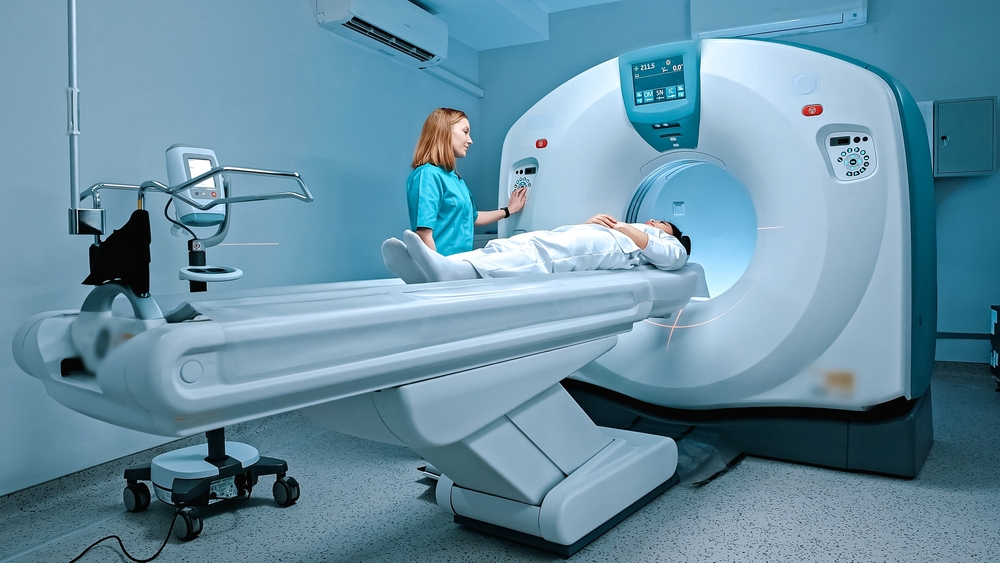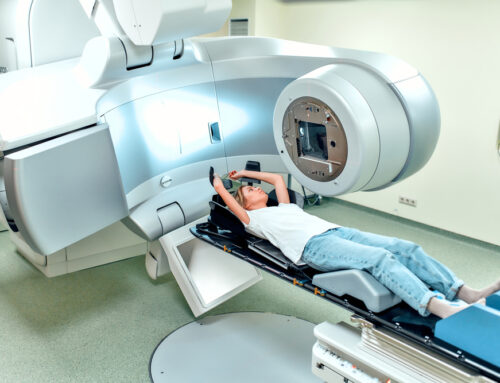Radiation therapy is a common treatment for cancer and other conditions, using high-energy rays to target and destroy abnormal cells. It can be delivered externally or internally, depending on the type and location of the disease. Understanding how it works, its potential side effects, and what to expect can help patients navigate their treatment with confidence.
Table of Contents
- You’ve Been Diagnosed with Breast Cancer. What Comes Next?
- The After Effects of Breast Cancer Radiation
- What To Expect After Your First Radiation Treatment?
- 5 Daily Habits You Can Take While Receiving Radiation Therapy
- 5 Foods That Doctors Approve During Radiotherapy
- Understanding Low Dose Radiation Therapy & Its Effects
- When is Brachytherapy Radiation a Viable Option?
- Pros and Cons of Brachytherapy
You’ve Been Diagnosed with Breast Cancer. What Comes Next?
Being diagnosed with breast cancer is a significant event that transforms more than one life. It is absolutely valid to feel overwhelmed and confused about what comes after such news, but we promise you that you can emerge stronger and more empowered than ever with the correct information, emotional support, and, most importantly, with a sensitive healthcare team to guide you and your loved ones every step of the way.
What Comes After a Diagnosis?

Emotional Well-being & Support
A breast cancer diagnosis can bring shock, fear, and sadness. Acknowledge these emotions without judgment and seek support from healthcare professionals, loved ones, or therapy for strength and resilience.
Exploring Treatment Options
Treatment varies based on cancer stage, health, and personal preferences. Common options include:
- Radiation Therapy: Uses high-energy rays to target cancer cells. Northwest Cancer Clinic offers advanced radiation oncology with precision technology to minimize side effects.
- Surgery: Options include lumpectomy (tumor removal) or mastectomy (breast removal).
- Chemotherapy: Uses drugs to treat cancer throughout the body.
- Hormonal Therapy: Blocks hormones that fuel cancer growth.
- Targeted Therapy: Attacks specific cancer cell molecules while sparing healthy cells.
Physical Health & Recovery
- Rest & Sleep: Listen to your body, aim for quality sleep, and manage fatigue.
- Nutrition & Exercise: Eat a balanced diet, stay hydrated, consult a dietitian, and engage in gentle exercise like walking or yoga.
The After Effects of Breast Cancer Radiation
Breast cancer radiation therapy is a standard treatment option for many women diagnosed with this condition. According to the National Library of Medicine, approximately 50% of all cancer patients receive radiation therapy during their process, and it contributes to 40% of curative treatment for cancer.
The investigations have shown the effectiveness of this type of breast cancer treatment for patients. However, it’s essential to acknowledge that, like any medical treatment, radiation therapy can have side effects. While these side effects can vary from person to person, understanding them can help you prepare and manage them effectively.
The Basics of Radiation Therapy
Radiation therapy uses high-energy rays to target cancer cells, often after surgery to reduce recurrence risk. There are two main types:
- External Beam Radiation Therapy (EBRT): Delivers radiation from outside the body.
- Internal Radiation Therapy (Brachytherapy): Places a radioactive source inside or near the tumor.
Both methods aim to destroy cancer cells while minimizing damage to healthy tissue.

Common Side Effects
- Skin Changes: Redness, dryness, irritation, or peeling.
- Fatigue: Persistent tiredness.
- Breast Changes: Swelling, tenderness, or shape alterations.
- Lymphedema: Swelling in the arm or hand.
- Heart Issues: Rare but possible long-term effects.
Managing Side Effects
- Skin Care: Use gentle cleansers and moisturizers; avoid sun exposure.
- Fatigue Relief: Prioritize rest and manage stress.
- Pain Management: Over-the-counter or prescribed medications.
- Lymphedema Care: Exercise, massage, and compression garments.
Long-Term Considerations
Some side effects, like heart disease or secondary cancers, may appear years later.
Emotional Support
Breast cancer treatment affects mental well-being. Counseling or therapy can help manage stress, anxiety, and depression.
What To Expect After Your First Radiation Treatment?
Radiation therapy is a common treatment option for cancer that uses high-energy rays or particles to target and destroy cancer cells. This therapy can help shrink tumors, alleviate symptoms, and improve survival rates for many cancer patients.
On the other hand, while it can be an effective and life-saving treatment, it’s normal to feel a range of emotions, especially after your first session. Fear, anxiety, or uncertainty are all common responses, and it’s important to know that you’re not alone in this journey.
Common Side Effects of Radiation Therapy & Management Tips
Radiation therapy can cause side effects, which vary based on the treatment area, cancer type, and radiation dose. Most are temporary and improve after treatment.

Skin Reactions
Radiation may cause redness, dryness, itching, and peeling, similar to a sunburn.
Management:
- Use mild, unscented soap and lotion.
- Avoid tight clothing and sun exposure.
- Apply doctor-recommended creams like aloe vera.
Fatigue
Tiredness is common and may increase as treatment progresses.
Management:
Prioritize rest and maintain a consistent routine.
Engage in light exercise, like walking.
Other Possible Side Effects
- Mouth sores, trouble swallowing (head/neck treatment)
- Nausea, vomiting (abdominal treatment)
- Swelling, inflammation in the treated area
- Diarrhea (pelvic/abdominal treatment)
When to Contact Your Doctor: If experiencing severe symptoms like breathing issues, weight loss, or bleeding.
Self-Care During Radiation Therapy
Nutrition & Hydration
- Eat a balanced diet with lean proteins, whole grains, fruits, and vegetables.
- Stay hydrated to prevent dry mouth and dehydration.
Stress & Emotional Support
- Practice meditation, deep breathing, or yoga to reduce stress.
- Seek support from loved ones, therapists, or cancer support groups.
5 Daily Habits You Can Take While Receiving Radiation Therapy
Undergoing radiation therapy for cancer can be an emotionally and physically demanding journey. Radiation is often a key part of cancer treatment, aiming to kill or damage cancer cells, but it can also affect healthy tissues and lead to various side effects.
While radiation therapy is effective in treating many types of cancer, self-care plays a crucial role in helping your body cope with the treatment, recover faster, and maintain overall well-being.
Healthy Habits During Radiation Therapy

1. Prioritize Rest
Radiation therapy often causes fatigue. Getting enough sleep helps your body heal and manage stress.
Tips:
- Keep your bedroom cool, dark, and quiet.
- Avoid screens 30 minutes before bed.
- Follow a relaxing bedtime routine.
2. Nourish Your Body
A balanced diet supports recovery and strengthens your immune system.
Tips:
- Eat small, frequent meals.
- Include protein-rich foods like lean meats and beans.
- Try smoothies if solid foods are difficult.
3. Stay Hydrated
Radiation can cause dehydration and dry mouth, making fluid intake essential.
Tips:
- Carry a water bottle and sip regularly.
- Aim for 8-10 cups of fluids daily.
- Try broths, herbal teas, or flavored water if plain water is unappealing.
4. Manage Stress
Stress can worsen physical symptoms, so relaxation is key.
Tips:
- Practice meditation or deep breathing.
- Engage in gentle yoga.
- Take breaks and focus on activities you enjoy.
5. Stay Connected
Emotional support is crucial during treatment.
Tips:
- Schedule regular chats with loved ones.
- Accept help with daily tasks.
- Share your feelings—it’s okay to seek support.
5 Foods That Doctors Approve During Radiotherapy
While radiation therapy effectively targets cancer cells, it can also cause side effects like fatigue, nausea, and changes in appetite. Maintaining a healthy radiation therapy diet during treatment is crucial to support the body’s healing process and improve overall well-being. A balanced diet can help patients manage side effects, preserve energy levels, and enhance recovery.
5 Doctor-Approved Foods for Radiotherapy Patients

1. Lean Protein
Protein is crucial for tissue repair, especially after radiation therapy. It helps maintain muscle mass and supports immune function, which is essential for recovery.
Recommended options:
- Skinless chicken breast
- Fish like salmon or cod
- Plant-based proteins like lentils, beans, and tofu
Including lean protein in your meals ensures your body gets the nutrients needed for healing and strength.
2. Whole Grains
Radiotherapy can cause fatigue, making it important to fuel your body with slow-releasing carbohydrates. Whole grains provide steady energy and essential nutrients like fiber, B vitamins, and minerals.
Recommended options:
- Brown rice
- Quinoa
- Whole-wheat bread and pasta
Unlike refined grains, whole grains support digestive health, which can be beneficial for those experiencing gastrointestinal side effects.
3. Fruits and Vegetables
Packed with vitamins, minerals, and antioxidants, fruits and vegetables help reduce inflammation and protect against oxidative stress caused by radiation. Eating a variety of colorful produce ensures a broad range of nutrients.
Recommended options:
- Berries (blueberries, strawberries, raspberries)
- Leafy greens (spinach, kale, Swiss chard)
- Vibrant vegetables (carrots, bell peppers, sweet potatoes)
These foods boost immune function and help the body recover more effectively.
4. Healthy Fats
Healthy fats play a key role in cell function and energy production. Omega-3 fatty acids, in particular, have anti-inflammatory properties that may benefit radiotherapy patients.
Recommended options:
- Avocado
- Nuts and seeds (almonds, walnuts, chia seeds)
- Olive oil and fatty fish like salmon or mackerel
Including healthy fats in your diet can also enhance the absorption of fat-soluble vitamins like A, D, E, and K.
5. Hydration
Proper hydration is essential for managing side effects like dry mouth, nausea, and digestive issues. Drinking enough fluids helps flush toxins and maintain energy levels.
Recommended options:
- Water
- Herbal teas like chamomile or peppermint
- Electrolyte-rich drinks such as coconut water or diluted sports drinks
A good way to monitor hydration is by checking urine color—pale yellow usually indicates adequate hydration.
What to Eat After Radiation Therapy
Post-radiation recovery requires a nutrient-rich diet to aid in tissue repair, reduce inflammation, and strengthen immunity. Lean proteins, whole grains, fruits, vegetables, and healthy fats remain essential. Avoid processed, sugary, and fried foods that can contribute to inflammation and slow recovery.
Consult your healthcare provider for personalized dietary recommendations to support your healing process.
Understanding Low Dose Radiation Therapy & Its Effects
Radiation therapy is a cornerstone in the fight against cancer, offering effective treatment options for countless patients. Among its various forms, low-dose radiation therapy (LDRT) has emerged as a unique approach that is transforming how certain diseases are treated. While high-dose radiation is often associated with cancer therapy, LDRT is gaining recognition for its precision, safety, and expanded applications.
Low-Dose Radiation Therapy (LDRT) Overview

What is LDRT?
LDRT delivers smaller radiation doses than traditional high-dose therapy, targeting diseased tissues while minimizing harm to healthy cells.
Key Differences from High-Dose Radiation Therapy
- Lower Intensity: Reduces severe side effects.
- Different Purpose: Used for symptom management and non-cancerous conditions rather than full cancer eradication.
- More Frequent Sessions: Smaller doses spread over time for better tolerability.
How LDRT Works
LDRT selectively damages abnormal cells, preventing their growth while minimizing harm to healthy tissue. It may also boost the immune system.
Benefits Over Traditional Therapy
- Fewer Side Effects: Less risk of tissue damage or scarring.
- Better Quality of Life: Helps alleviate pain and discomfort.
- Broader Use: Suitable for non-cancerous conditions and patients intolerant to high-dose therapy.
Uses of LDRT
Cancer Treatment
- Lymphomas & Leukemias: Effective in treating blood cancers.
- Early-Stage Tumors: Used alone or alongside other therapies.
Palliative Care & Pain Relief
- Reduces pain from bone metastases.
- Shrinks tumors affecting vital functions.
Other Medical Applications
- Inflammatory Conditions: Treats arthritis, tendinitis, and other benign diseases.
- Skin Disorders: Used for certain dermatological conditions.
Side Effects & Safety
Common Side Effects
- Mild skin reactions (redness, itching).
- Temporary fatigue.
- Localized pain.
Long-Term Risks
- Repeated sessions may cause tissue damage.
- Rare risk of secondary cancers or organ issues.
Safety Measures
- Minimized Exposure: Tailored treatment plans reduce risks.
- Medical Supervision: Regular monitoring ensures safe application.
- Advanced Technology: Enhances precision to protect healthy tissues.
When properly managed, LDRT offers an effective, low-risk treatment option for various conditions.
When is Brachytherapy Radiation a Viable Option?
Brachytherapy is an innovative form of cancer treatment that offers targeted radiation to fight tumors. This treatment is gaining attention for its precision and effectiveness in addressing specific types of cancers. But when is brachytherapy a viable option, and how does it compare to other radiation therapies?
What is Brachytherapy?
Brachytherapy is an internal radiation therapy where radioactive material is placed inside or near the tumor. Unlike external radiation, it delivers high-precision treatment while minimizing exposure to healthy tissues.

How It Works
Small radioactive seeds or pellets are implanted at the tumor site using imaging guidance. These sources emit radiation over time, destroying cancer cells with minimal impact on surrounding tissue.
Conditions Treated
- Prostate Cancer: A common treatment for localized cases, offering high success rates.
- Breast Cancer: Used post-lumpectomy to reduce recurrence risk.
- Cervical Cancer: Often combined with external radiation for enhanced effectiveness.
- Skin Cancer: Treats non-melanoma lesions with targeted precision.
- Other Cancers: Applied in head, neck, and ocular cancer treatments.
Advantages
- Precise Targeting: Direct radiation to tumors with minimal healthy tissue exposure.
- Minimally Invasive: Requires minor surgical placement, leading to faster recovery.
- Shorter Treatment Duration: Often completed in fewer sessions than external radiation.
- Fewer Side Effects: Less fatigue, skin irritation, and organ damage.
Disadvantages
- Potential Side Effects: Localized discomfort and tissue damage possible.
- Not Suitable for All Cancers: Less effective for advanced or widespread cases.
- Requires Expert Planning: Needs precise imaging and skilled specialists for best results.
Is Brachytherapy Right for You?
Consulting a radiation oncologist and undergoing imaging tests (CT, MRI, or ultrasound) help determine if brachytherapy is suitable for your condition.
Pros and Cons of Brachytherapy
Brachytherapy radiation is a specialized form of cancer treatment that involves delivering radiation directly to the tumor site. This internal radiation therapy can provide several benefits for patients with certain types of cancers, but like any medical treatment, it comes with both pros and cons.
What is Brachytherapy?
Brachytherapy is an internal radiation therapy used for treating localized cancers like prostate, cervical, and breast cancer. Unlike external beam radiation, it delivers radiation directly inside or near the tumor, minimizing damage to healthy tissues.

How it Works
Small, sealed radioactive sources are implanted temporarily or permanently in or near the tumor, ensuring a precise and concentrated radiation dose. This approach enhances effectiveness while reducing exposure to surrounding tissues.
Pros of Brachytherapy
- High Precision: Direct radiation minimizes harm to healthy tissue, making it ideal for sensitive areas.
- Minimally Invasive: Requires only small incisions, leading to faster recovery and fewer complications.
- Shorter Treatment Time: Often completed in fewer sessions than external beam radiation.
- Fewer Side Effects: Reduces risks like skin irritation and fatigue due to its targeted nature.
Cons of Brachytherapy
- Potential Side Effects: May cause temporary skin irritation, fatigue, or localized discomfort.
- Limited Applicability: Best for localized tumors; not suitable for larger or metastasized cancers.
- Requires Careful Planning: Precise placement of radioactive sources demands detailed imaging and preparation.
- Temporary Precautions: Patients may need to avoid close contact with certain individuals post-treatment.
Brachytherapy vs. External Radiation
Brachytherapy delivers targeted radiation with fewer side effects, whereas external beam radiation affects a broader area, often causing more pronounced side effects like burns and digestive issues.
Important Considerations
- Individualized Treatment Plans: Oncologists assess tumor type, stage, and patient health to determine suitability.
- Weighing Risks and Benefits: Patients should discuss options thoroughly with their healthcare team.
Brachytherapy offers precise, minimally invasive cancer treatment with fewer side effects, though it requires careful planning and is not suitable for all cancers.
Explore Your Treatment Options with Experts
Radiation therapy plays a crucial role in treating various conditions, particularly cancer, by targeting and eliminating harmful cells. While side effects can occur, advancements in technology have made the treatment more precise and manageable. With proper guidance and support, patients can undergo radiation therapy with a clearer understanding and greater peace of mind about the process.
Contact us today at Northwest Cancer Clinic to discuss your options and receive personalized guidance. Our team is here to support you throughout your treatment journey.






